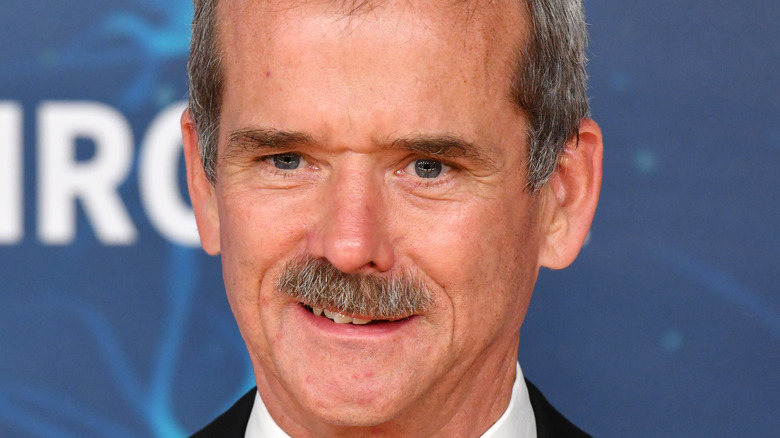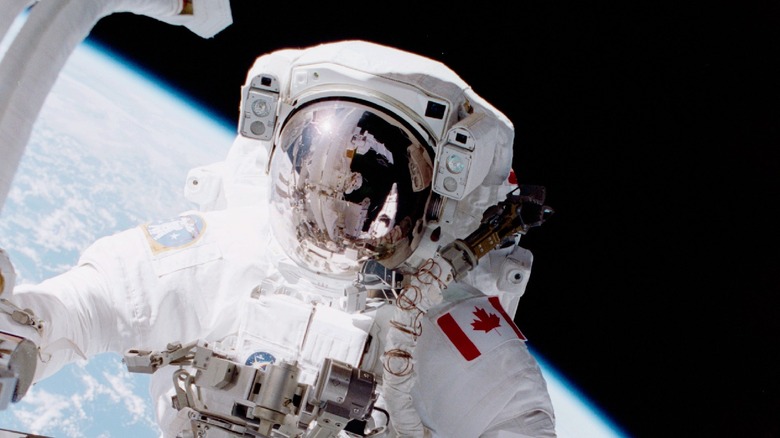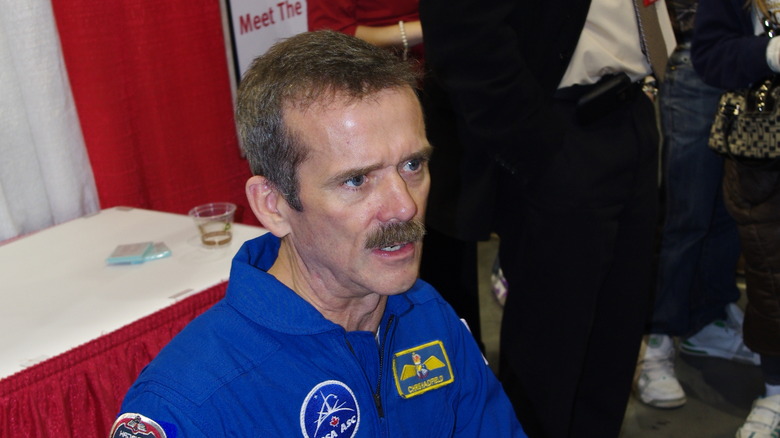Astronaut Chris Hadfield Recorded An Album That Was Literally Out Of This World
Canadian astronaut and musician Chris Hadfield has had quite a career — but nothing quite beats the time he recorded most of an album in space while onboard NASA's international space station. With 11 original songs as well as a cover of David Bowie's "Space Oddity," the album — "Space Sessions: Songs from a Tin Can" — was mostly composed in low gravity.
Hadfield himself noted his long career fronting bands to Ars Technica and explained how he recorded "Space Oddity." He's been a musician for quite a while — he was in the astronauts-only band Max Q — but never in space, so had to resort to creative ways to, for example, tie the guitar down while in zero gravity so he could play it properly. Both the guitar and his vocal tracks were recorded while on board the space station.
The album was released in the fall of 2015, two years after Hadfield retired from being an astronaut. He's very proud of his recording work. "I think seeing and understanding the process and the human side of it is a really important part of the creation of new things in the exploration of new places," he explained to Ars Technica in his song recording breakdown.
How did he record an entire album in space?
While packing for his six months onboard NASA's International Space Station, Chris Hadfield added in an acoustic guitar, two plastic guitar picks, and his laptop, writes Phys.org. He made a basic sign for his time on the space station that said "Recording in Progress," using it to make sure everyone else stayed relatively quiet while he recorded original music and a David Bowie cover (per The Georgia Straight). Hadfield used Apple's music program GarageBand to put together his recordings, according to LifeGate.
His original pieces, similarly to Bowie's "Space Oddity," dealt with his feelings regarding being in space. They are mainly blues and rock pieces and are mostly rhythm driven. After Hadfield got back in the middle of 2013, he decided to take the recordings and turn them into an album. The album sales have been used to support Canadian music schools.
NASA's psychologists encouraged Hadfield's playing, feeling that music and art could only be to the benefit of astronauts' mental health. The guitar he played, a Larrivee Parlor, was originally brought on the international space station in 2001 and has been played by a score of astronauts and cosmonauts (via LifeGate). No one other than Hadfield used it to compose and record an album.
Recording Space Oddity in his spare time in space
Commander Chris Hadfield recorded the video himself for his version of David Bowie's "Space Oddity" during his free time while working on NASA's international space station. As he explains to Ars Technica, the video was requested by fans, and he happily complied, even updating some of the lyrics to indicate what spaceflight had actually become since the song was written. When Bowie wrote it, he was only imagining what it would be like to be in space.
Hadfield had a difficult time hanging onto the guitar when he recorded due to zero gravity and even said that he needed to put up two lights aimed at his face to avoid washing out the shot (considering the brightness of Earth's light right behind him). He also used zero gravity to his advantage when recording by allowing the camera to float and slowly turn in the air. Hadfield hooked himself into handrails on the spaceship so that he would stay upright and float, with the guitar turning slowly in front of him. Hadfield did want to make it very clear that the video was filmed in space, and with his shots, he succeeded. He managed to complete the filming in around an hour and a half on a free Saturday.
Hadfield told Ars Technica that David Bowie was pleased with the outcome, saying that "he described it as the most poignant version of a song ever done."


